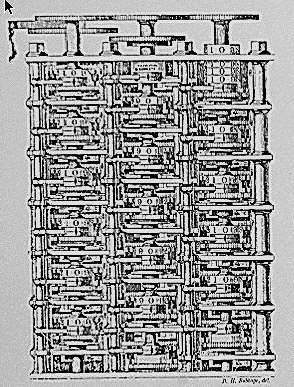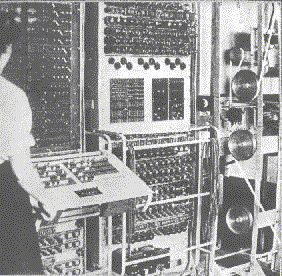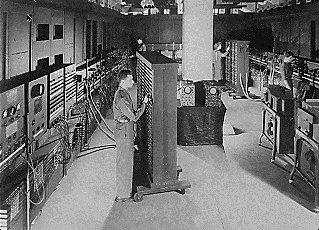I find the history of the computer a fascinating story, and I hope you will to.
|
After reading this you can impress your friends and peers with your Computer history knowledge.
|
|
We can trace human attempts to create tools to manipulate data at least as far back as 2600 B.C, when the Chinese invented the abacus. All early computers were mechanic and usually operated by hand.
|
|
The next major invention some say was in 1830 when Charles Babbage invented the Analytical Engine, which could make decisions, such as sequential control, branching and looping based on results of it's own computations. But unfortunately Charles Babbage died in 1871 without finishing his design. Although his design was built between 1989 and 1991 by members of the science museum in London.
|
|
One of the next major steps was in 1888 when Herman Hollerith invented a mechanised system of paper cards with holes in them to tabulate the U.S Census. The system tabulated the results in six weeks instead of the seven years it would have taken to tabulate the Census by hand. It is worth noting the Herman Holleriths Computing, Tabulating, Recording Company changed it's name in 1924 to International Business Machines (yes you guessed it IBM).
|
|
Then in 1904 John Ambrose Flemming created the diode vacuum tube. The vacuum tube meant that computers did not have to be made of gears and pulleys that were full size and were worked by hand. The vacuum tube could act as a switch turning on and off, thousands of times faster than mechanical contraptions.
|
|
Computer progress took on a whole new meaning during World War Two, when in 1943 the British created Colossus. Colossus was built to break the codes produced by the Enigma encrypting machine developed by the Germans. During my research I was amazed to find that the American government was given the details of Colossus by the British government as part of payment for all the food and armaments America had supplied throughout the war. At the time the British government did not see a civilian use for computers, even the Americans only thought that a handful of computers would supply all the Worlds needs forever..........How wrong they were.
|
|
|
|
|
|
|
|
|
The war also gave birth to ENIAC (Electronic Numerical Integrator Analyser and Computer), built between 1943 and 1945 by the U.S Army, to produce missile trajectory tables.
|
ENIAC performed 5,000 additions a second, cost $500,000, weighed 30 tons and was 100 feet long and 8 feet high but consumed 200 kilowatts of electricity an hour and was prone to cooking it's own components. It is said that the lights of surrounding Philadelphia dimmed when they switched the ENIAC on.
|
|
It wasn�t until 1954 that the modern computer took off, it was in this year that Texas Instruments created a way to produce silicon transistors commercially. In this same year IBM introduced the 650, this was to become the first mass produced computer with 150 bought in the first year.
|
In 1975 the Altair 8800 was made by Micro Instrumentation and Telemetry Systems (MITS). The 8800 cost $367 and included an Intel 8080 microprocessor and 256 bytes of memory. There was no keyboard, programmes and data were inputted by flicking switches on the front of the Altair. The Altair also had no monitor, so results were read by understanding or interpreting the pattern of red lights on the front.
|
MITS received 4,000 orders within a few weeks.
|
|
It is widely accepted that the development that made computers available to the masses was the IBM PC. What made this development different was that IBM made the overall design of the PC available to competitors, but IBM did copyright the BIOS. This assured that all IBM clones helped establish IBM architecture as the machine that software and hardware developers would design for.
|
The computer has really grown from there at a phenomenal rate, and considering computers are still relatively new. The rate of development of computers means that no sooner have you bought your P.C. than it is already effectively out of date, as faster and bigger components are developed.
|
|
It is stated in Moores Law that the �the number of transistors that can be created on a chip doubles every 18 months�; this is to say that a 400 MHz processor in 18 months is replaced in effect by a 800 MHz processor.
|
But how long can this process last?, I hear you ask.
|
|
Well a recent breakthrough in chip technology by developers at Bell Labs has the potential to turn the computing world on its head.
|
Currently chip technology consists of a process where thousands of transistors are etched onto a silicon substrate. As more and more transistors are placed side by side in a smaller and smaller area, there reaches a point where the chemical properties cannot be controlled. However at Bell Labs they have managed to �stand-up� the transistors on the chip, instead of creating transistors in a horizontal position.
|
So look out for a leapfrog in processor capacity in the future due to this new technology.
|
|
The history of the PC does include a lot more developments, especially in the 70s, and 80s, I will hopefully include these if there is a demand for the information.
|









